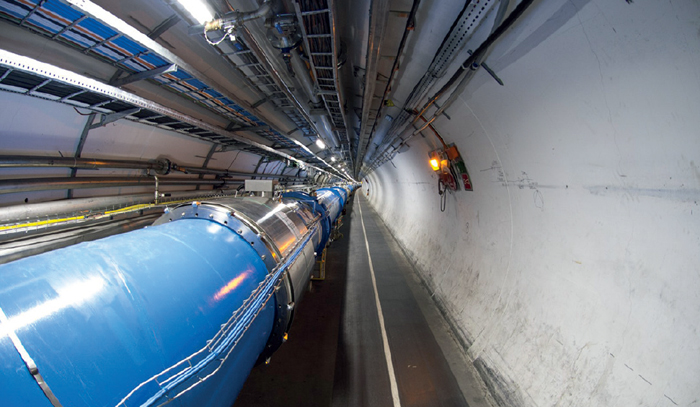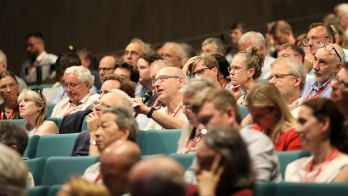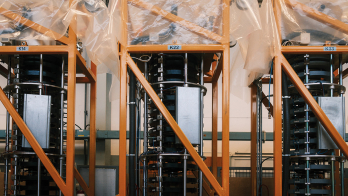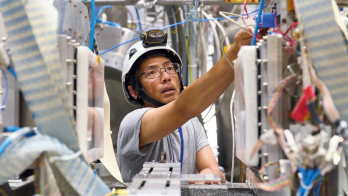A fresh look at the case for an electron–hadron collider.
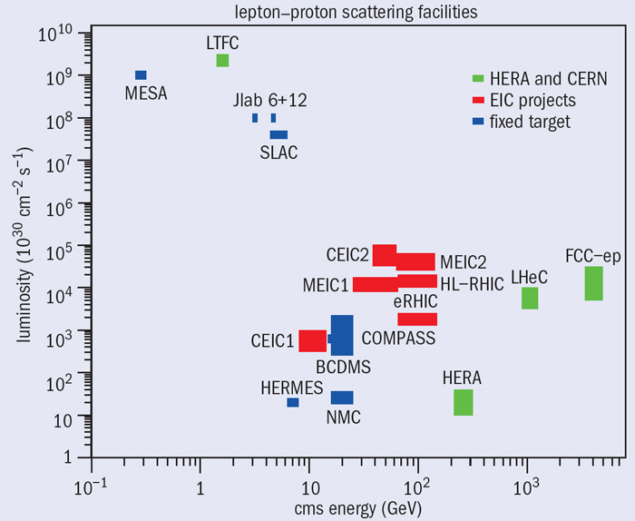
From time to time, great experimental progress in particle physics suddenly reveals a crisis in theoretical physics. This happened in the early 1960s when a plethora of hadrons had been discovered, while strong-interaction theory dealt with analytical properties of the S matrix and a number of phenomenological models. At that time, Murray Gell-Mann, who had just introduced the notion of quarks, seconded by Georg Zweig, argued for focusing on “a higher-energy accelerator so that we can do more experiments over the next generation and really learn more about the basic structure of matter” (Gell-Mann 1967). The current situation is not so different.
At the LHC, the Standard Model is being subjected to a thorough confirmation, including the remarkable completion of its particle contents with the discovery of a Higgs boson. Important as these results are, however, there is still no indication of the existence of the long-predicted supersymmetric particles or of Kaluza–Klein resonances below a mass scale of about a tera-electron-volt, or of other new phenomena. Of course, the hope is that in the coming years the LHC will discover new physics in exploring the next higher-energy domain with increased luminosity. Yet, to discover all hidden treasures when entering unknown territory, it is a wise strategy to prepare for all possibilities and not to rely on a few choices only.
In this spirit, investigations of electron–proton (ep) and electron–ion (eA) collisions at high energies offer an important prospect, complementary to proton–proton (pp) and electron–positron (ee) collisions. So far, the only collider to exploit the ep configuration was HERA at DESY, where results from the H1 and ZEUS experiments provided much of the base of current LHC physics and also led to surprising results, for example on the momentum distributions of partons inside the proton. Building on the conceptual design study for the Large Hadron Electron Collider (LHeC) – an electron-beam upgrade to the LHC – CERN’s management decided recently to investigate these possibilities more deeply. It has established an International Advisory Committee (IAC) to report to the director-general, with the mandate to provide “…scientific and technical direction for the physics potential of the ep/eA collider, both at the LHC and FCC [the proposed Future Circular Collider complex], as a function of the machine parameters and of a realistic detector design, as well as for the design and possible approval of an energy recovery linac (ERL) test facility at CERN…”. Furthermore, the advisory committee should offer “assistance in building the international case for the accelerator and detector developments as well as guidance to the resource, infrastructure and science policy aspects…”. Chaired by Herwig Schopper, the IAC comprises 12 eminent scientists from three continents, together with CERN’s director for research and computing, Sergio Bertolucci, and the director for accelerators and technology, Frederick Bordry, as well as the co-chairs of the newly established LHeC Co-ordination Group, Oliver Brüning and Max Klein.
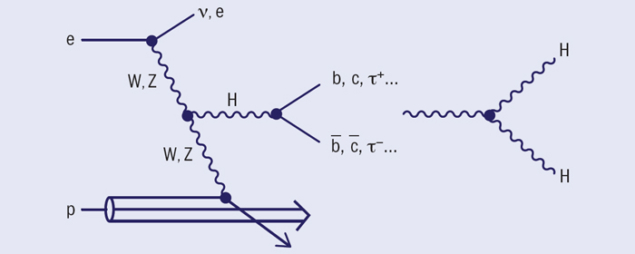
One of the IAC’s first major activities was to hold a well-attended workshop on the LHeC, its physics, and the accelerator and detector development, at Chavannes-de-Bogis in January this year. At the meeting, Stefano Forte classified deep-inelastic scattering (DIS) physics at the energy frontier – which becomes accessible with ep collisions using the LHC’s proton beam (figure 1) – into three major areas. One area consists of high-precision measurements of the Standard Model, with the experimental and theoretical programme aiming for a per mille determination of the strong coupling constant, αs, and the reduction of uncertainties in searches at the High Luminosity LHC (HL-LHC) at high mass scales as prime examples. A second area concerns exploration of the parameter space, with Higgs physics – including the challenging decays into b and c quarks (figure 2) – as the obvious and most important element. The cross-section for such processes at the LHeC would be about 200 fb, enabling unique measurements of the Higgs properties from WW–H and ZZ–H production in ep scattering. With its unprecedented precision in determination of the parton distributions and of the strong coupling, the LHeC could assist in transforming the LHC into a precision Higgs factory. Lastly, there is what Forte called “serendipity”, meaning room for “known or unknown” discoveries. Indeed, a big step to higher energy with perhaps 1000 times the luminosity of HERA could lead not only to new insights but to breakthroughs, especially in the understanding of QCD.
Given the exploration of novel QCD phenomena such as quark–gluon plasma in heavy-ion collisions at the LHC – and also because HERA never scattered electrons off deuterons or heavier ions – a programme of electron–ion physics at the LHeC collider would be of great interest. It would extend the kinematic range in terms of four-momentum transfer squared, Q2, and the inverse of Bjorken-x, by nearly four orders of magnitude. This could reveal unexpected phenomena and would put the understanding of the partonic structure of the neutron and nuclei, and the exploration of high-density matter, on firmer theoretical ground.
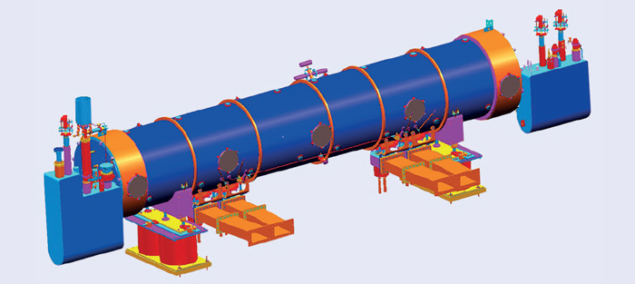
Image credit: SRF Institute, Jefferson Lab.
The vision of a 50 TeV proton (and about 20 TeV lead-ion) beam from the FCC opens a further horizon to future DIS measurements, which, for example, would access contact-interaction scales of a few hundreds of tera-electron-volts, could study lepton–quark resonances should these exist, and determine the Higgs self-coupling based on an inclusive Higgs-production cross-section of 2pb, which is much larger than the “Higgs-strahlung” cross-section at the International Linear Collider or the electron–positron FCC (FCC-ee).
A unique strength of the LHeC rests on the prospect of measuring parton distributions much more accurately than previously and of unfolding them without symmetry assumptions for the first time. This would remove a substantial part of the uncertainty of Higgs production in pp collisions, which dominantly occurs proportional to the square of the gluon distribution (xg) times the strong coupling constant. The measurement of Higgs production across a larger rapidity range in pp scattering at the FCC extends down to extremely small values of Bjorken-x. In this range, which is also of interest for ultra-high-energy neutrino scattering, the extrapolations of the current xg parameterizations no longer have any basis, and they differ hugely. Moreover, it is expected that nonlinear gluon–gluon effects set in, possibly leading to a saturation of gluon-dominated interaction cross-sections. The clarification of the laws of parton evolution at Bjorken-x < 10–4, most likely leading to the end of validity of the linear so-called DGLAP evolution equations, is impossible without a DIS programme of the kind considered here, and is essential for the pursuit of a sound programme in pp physics at the energy frontier at CERN.
The Higgs discovery has led to a reconsideration of the luminosity needs at the LHeC – a further focus of the Chavannes workshop. The conceptual design report (CDR) was directed at achieving an instantaneous luminosity of about 1033 cm–2 s–1 in synchronous ep and pp operations at the LHC (LHeC Study Group 2012). A substantial increase of this value is desirable, with the goal of producing 105 Higgs bosons across a 10-year period of operation. This would open the route to a 1% precision measurement of the decay H → bb, thanks to the clean final-state signature and the absence of pile-up. Such an increase of luminosity might be possible owing to the beam brightness of the HL-LHC, which is expected to be 2–3 times higher than assumed in the CDR, through doubling the electron-beam current to 10–20 mA and also by reducing the focusing of the proton beam in the ep interaction region. It is one of the goals of the new ep study initiated by CERN to understand the implications of high-intensity ep operation on the design of the interaction region and on the simultaneous operation of the LHC envisaged.
It has always been the tradition at CERN to plan a long time ahead carefully
A deeper study of the possibility for an ep and eA collider at CERN shows that development of the technique of energy recovery is necessary. This is possible when the maximum energy beam is decelerated with a phase shift in the same superconducting RF cavity structure used for acceleration. An energy-recovery linac provides a unique opportunity to achieve high energy and high luminosity by efficient use of the available power. In the case of the LHeC design, a beam power of about 25 MW is used. This would correspond to a power of almost 1 GW if there were no energy recovery. In conjunction with the renewed study of ep at CERN, the decision has been made to design and build a set of two cryogenic superconducting RF-cavity modules in collaboration with experts at Jefferson Lab in the US and at Mainz University (figure 3). About 7 m long, one module comprises four cavities of a five-cell low-loss shape with a higher-order-mode coupler and supply end-can. The design is for a frequency of 802 MHz, with a few modules to be built for test purposes at CERN and Jefferson Lab and for the MESA project at Mainz. In a workshop last year, 802 MHz was chosen as a more-or-less optimum value for beam stability, cavity dimensions, RF power, dynamic losses, etc, and in view of the LHC and choices for the FCC developments also.
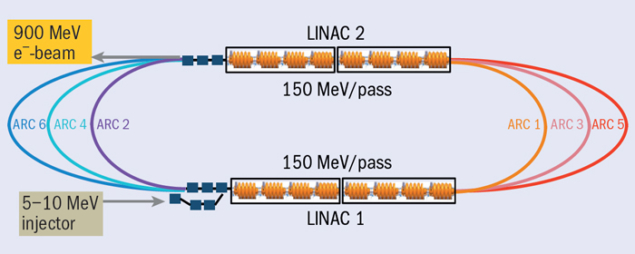
Image credit: Alessandra Valloni/CERN.
The two cryo-cavity modules could serve as the initial building blocks for an ERL test facility at CERN – the LTFC (figure 4). Its design, scheduled for 2015, is being undertaken in international collaboration. This test facility would have a variety of important goals: the development of superconducting RF at CERN under realistic operational beam conditions, with high gradients for continuous-wave operation (< 20 MV/m) and of high quality (Q0 > 1010); the development of high-current electron sources, which are also required for the FCC-ee; and further applications, such as magnet quench tests in a low-radiation environment and detector tests with an electron beam on-site of up to 1 GeV energy.
In addition to the many topics in deep-inelastic scattering that can be studied with the LHeC and the hadron–electron FCC (FCC-he), there is also an intimate relationship between ep physics and physics at pp and ee colliders. This was already evident when HERA, the Tevatron, the Large Electron–Positron Collider and the SLAC Linear Collider explored the Fermi scale. It is clear, not only from the example of Higgs studies, that this will also be the case at the energy scales of the LHC and the proposed FCC hh-ee-he complex. A new energy-frontier ep and eA project would naturally exploit the major investments in hadron beams at CERN. It would not become a flagship activity for CERN, since it would reside essentially at one experimental location, which could not satisfy the majority of the particle-physics community. However, such a project would provide a complementary window for the main upgrade programmes and would potentially lead into the distant future.
It has always been the tradition at CERN to plan a long time ahead carefully, with the result that all big projects were achieved on time and to budget, and were also scientifically and technically successful. This is one of the secrets of CERN’s success. Close co-operation between theory, experiments and technology was always essential for this to work. One aim of this article is to encourage collaboration on the test facility, on the accelerator, on the ep/eA detector being designed, and on the understanding and evaluation of an electron–proton and electron–ion physics programme at the energy and intensity frontier at CERN that would be worth pursuing.



